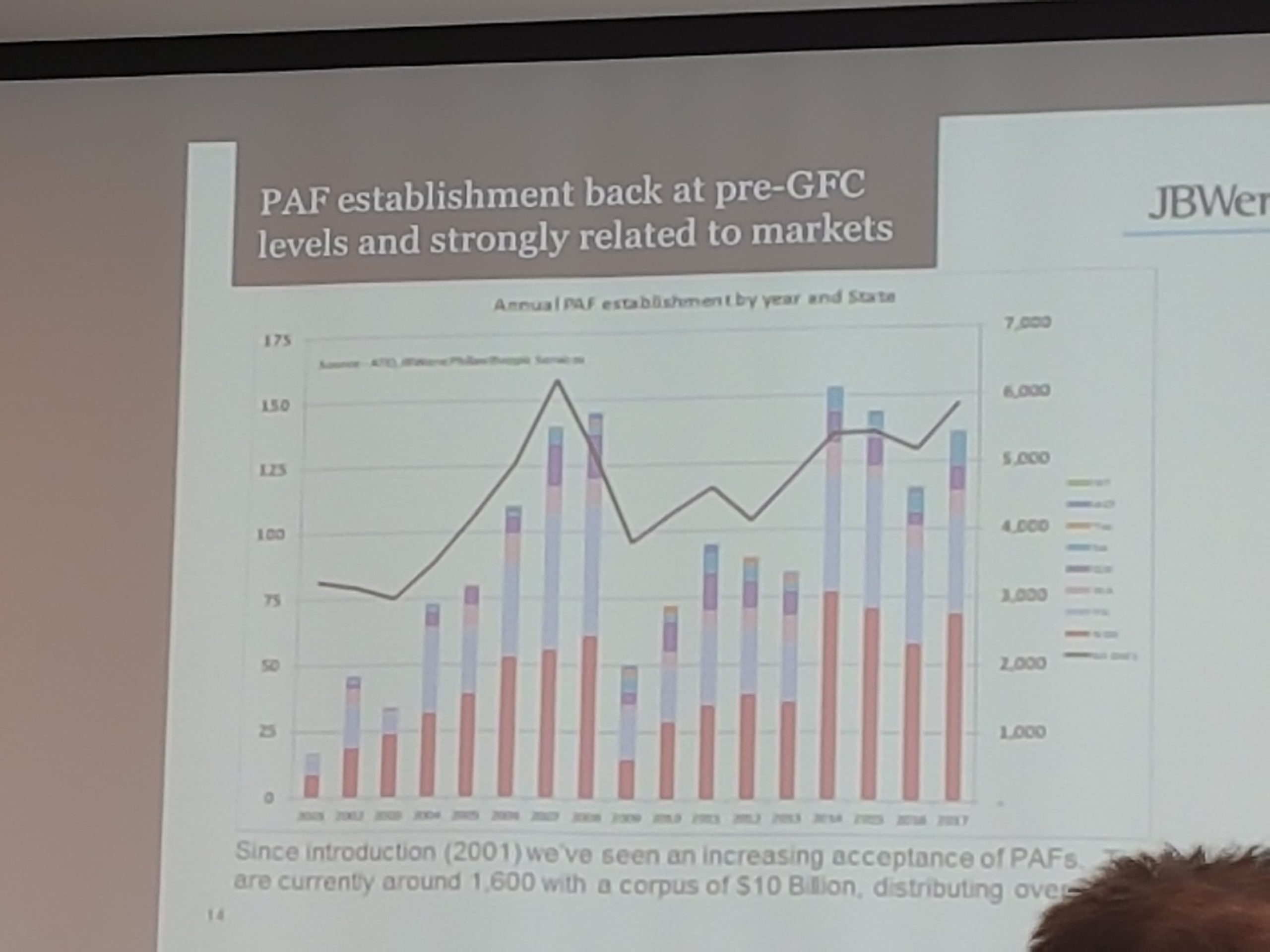The launch of JB Were’s Support Report: The changing shape of giving and the significant implications for recipients held in Brisbane late March, was full of essential statistics for strategic fundraising planning, and calls to sectoral action by both John McLeod (Philanthropy Australia Council Member and JBWere report author), and Associate Professor Wendy Scaife (ACPNS); including the recommendation for a ‘slip, slop, slap’ style campaign around the benefits of philanthropy and giving.
The soon to be released report, a companion to The Cause Report (April 2016), examines the evolution of philanthropy and supported causes over time in Australia, and predictions for the future of philanthropy that are essential for non-profits to understand and begin to plan ahead to ensure sustainable operations into the future.
The Changing Funding Landscape
The top 10% of charities (around 5,000 of them) get 94% of all available funds. That’s stiff competition, and certainly speaks to the benefits of having big, well-resourced and educated professional fundraising teams. But, as Wendy Scaife said, it’s also important to be able to pivot: to scrutinise performance, change tack, redefine goals and decision processes, rethink roles, and become thought leaders. Some of these things can be easier to achieve for smaller organisations, where there’s not such a behemoth to turn about!
While constituting only 8% of non-profit funding, the Support Report shows how important the philanthropic dollar is for funding activities other sources won’t or can’t fund. The philanthropic dollar is the risk capital of the sector, funding new breakthroughs and innovations that other types of funders can then jump on board to scale up.
Both Government and philanthropy have grown faster as a provider of sector revenue than other sources, with Government outsourcing services to non-profits. However, the growth of Government funding is now expected to plateau.
Concerningly, self-earned income is fast dropping as a source of revenue for non-profits to maintain financial sustainability. It’s vital for Social enterprise and other income earners to increase as a percentage of non-profit earnings to maintain sectoral growth.
John stated ‘Over time, organisations have also grown much more reliant on volunteering. It’s a huge part of the operational model of many organisations’. That said however, John’s opinion is that volunteering proportions have now plateaued, so a strong reliance on volunteers is a risky strategy.
Who funds what…
Each funding type has different interest areas they are keen to fund. The mass market (individual donors) tend to cluster around religion and international aid – followed by health, social services, emergency relief and income support.
High net wealth individuals (the rich list) tend to give most to universities, culture and arts, health and medical research. However, four out of ten affluent Australians are not claiming tax deductions! Evidence of the need for a pro-philanthropy campaign, certainly.
PAFs, who have a collective corpus of around $10 billion and are distributing over $500 million per annum, are giving the majority of their funds to welfare causes. However, those 1,600 PAFs are more diverse in the causes they give to compared to other types of funders.
Bequests are still only being made by 7.4% of the population, however with the increase in the asset value (of houses) and the baby boomer bulge, dollars from bequests as a proportion of a charities’ revenue is expected to rise.
Paul Ramsay Foundation is in top position in terms of the dollar amount they are giving, with a considerable funding gap between them and the next highest funder in Australia; the difference is notably higher even compared to the funding gap between the Bill and Melinda Gates Foundation (largest grant funder in the U.S.) and the second highest funder in the U.S.

The Future is coming!
John pointed to the difference in large corporates and small corporates in the way they give and noted it’s important for charities to consider ‘what is the best fit for my organisation?’ when researching prospective corporate partners, rather than ‘who has the most money?’.
Larger corporates tend to give by long term partnerships with an expectation of shared value, in-depth relationships and sometimes a skilled volunteering component. Smaller enterprises look for community benefit and are generally more inclined to simply write a cheque.
And in the future? John expects we’ll see a continual growth of both PAFs and Corporate Partnerships – something to consider when planning your funder stewardship processes and resourcing!
And the good news about PAFs if you’re a smaller organisation? They tend not to give so frequently to large organisations but look for smaller charities they can have a relationship with (says John who himself has a family PAF).
Wendy Scaife posed some questions for charities to consider as they plan for the future:
What’s changing around us?
Where are we at?
Are we ready for change?
What changes are needed?
And backing up the constant messaging in our Strategic Grant workshops to ensure your projects are based on your mission and strategy, Wendy said ‘It’s important that non-profits be moulding philanthropy by thinking about the most important things that need solutions, not chasing the next grant round”. “To address ‘wicked’ problems” Wendy says, “as a sector we need to get out of silos and into collaboration – not just with other non-profits but across sectors too”. The future of AI, data access, changing privacy, security, sharing, analytics, synthetic biology, technology, robotics, market scrutiny on charities through ratings schemes requires interdisciplinary thinking!
Wendy shared some great resources for future-proofing/planning in her talk, too. Check them out!
Philanthropy 2173 (what will philanthropy look like in the year 2173?): https://philanthropy.blogspot.com.au/
Third Sector Foresight (this UK site provides insight and planning tools for the community sector): http://www.3s4.org.uk/
Philanthropy and Digital Civil Society: Blueprint 2018: https://pacscenter.stanford.edu/publication/philanthropy-and-digital-civil-society-blueprint-2018/
Our Future World: Global Megatrends Report https://www.csiro.au/en/Do-business/Futures/Reports/Our-Future-World